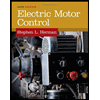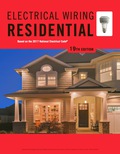
Connect 1 Semester Access Card For Electric Motors And Control Systems
2nd Edition
ISBN: 9781259550195
Author: Petruzella, Frank
Publisher: MCGRAW-HILL HIGHER EDUCATION
expand_more
expand_more
format_list_bulleted
Concept explainers
Question
Chapter 4.4, Problem 2DT
To determine
The manner in which a flow switch might be used in thebuilding fire protection system.
Expert Solution & Answer
Want to see the full answer?
Check out a sample textbook solution
Students have asked these similar questions
2. For the OPAMP below:
g) Grounding the inputs, perform a DC analysis (assume beta is infinite and VBE=0.7V and neglect the early voltage),calculate the DC currents and voltages everywhere in the circuit (all the collector and emitter currents and voltages aswell as the output voltage). Note that Q4 is 4 times as big as Q9 and Q3h) If Q1 and Q2 have a beta of 100, calculate the input bias current to the opampi) What is the input common mode range of this opamp?j) Calculate the common mode gain if the early voltage of Q3 and Q6 is 50Vk) Calculate the differential gain vo/vid of this circuitI) Calculate the input and output impedance of the opamp assuming beta is 100m) Calculate the input referred offset (Vos) if R2=21K
1. For the difference amplifier below, R1=R3=10K, R2=R4=50k, assume opamp is ideala) Find the differential mode gain, Admb) Find the input impedance (differential, between wi and va)c) Find the common mode gain in the presence of resistor mismatch (If R3=R1+ deltaR1, R4=R2+ deltaR2, deltaR1=100, deltaR2=500)d) Find the common mode rejection ratio (CMRR)e) Find the input impedance and output impedancef) If the OPAMP has an input current of 100uA, find the output offset voltage, set Vi1 = Vi2=0V
For the circuit shown, I-20 mA, R₁ =10000 2, R2 =2000 Q, R3 -2000 Q, R₁-6000 2, Vcc 5 V and the
OPAMP is ideal with regions of operation are considered.
The output current lo in mA is (choose the closet value):
R₂
Is
R₁
W
VCC
-VCC
The relative tolerance for this problem is 1 %.
-0.458
-0.833
6.667
-6.667
○ 0.458
0.833
w
R3
w
RL
Chapter 4 Solutions
Connect 1 Semester Access Card For Electric Motors And Control Systems
Ch. 4.1 - Prob. 1RQCh. 4.1 - Prob. 2RQCh. 4.1 - What do the terms normally open and normally...Ch. 4.1 - The types of enclosures used to house motor...Ch. 4.1 - Prob. 5RQCh. 4.1 - Compare the operation of momentary and maintained...Ch. 4.1 - What is the OSHA requirement for resetting...Ch. 4.1 - Prob. 8RQCh. 4.1 - Explain how a push-to-test pilot light operates.Ch. 4.1 - Compare the way in which pushbutton and selector...
Ch. 4.1 - Prob. 11RQCh. 4.2 - Define the term mechanically operated switch.Ch. 4.2 - In what way are limit switches normally actuated?Ch. 4.2 - A control application calls for an NC held open...Ch. 4.2 - List four common types of limit switch operator...Ch. 4.2 - Prob. 5RQCh. 4.2 - Prob. 6RQCh. 4.2 - For what types of machine control applications are...Ch. 4.2 - How does a fluid capillary tube temperature switch...Ch. 4.2 - Prob. 9RQCh. 4.2 - Prob. 10RQCh. 4.3 - In general, how do sensor pilot devices operate?Ch. 4.3 - What is the main feature of a proximity sensor?Ch. 4.3 - List the main component of an inductive proximity...Ch. 4.3 - Explain the term hysteresis as it applies to a...Ch. 4.3 - How is a two-wire sensor connected relative to the...Ch. 4.3 - In what way is the sensing field of a capacitive...Ch. 4.3 - For what type of target would a capacitive...Ch. 4.3 - Prob. 8RQCh. 4.3 - Name the three most common scan techniques for...Ch. 4.3 - What are the advantages of fiber optic sensing...Ch. 4.3 - Outline the principle of operation of a Hall...Ch. 4.3 - Outline the principle of operation of an...Ch. 4.3 - List the four basic types of temperature sensors...Ch. 4.3 - Compare the way in which a tachometer and magnetic...Ch. 4.3 - Outline the principle of operation of an optical...Ch. 4.3 - What approach is usually taken to measurement of...Ch. 4.3 - Prob. 17RQCh. 4.4 - Define the term actuator as it applies to an...Ch. 4.4 - In what ways are electromagnetic relays employed...Ch. 4.4 - Prob. 3RQCh. 4.4 - Prob. 4RQCh. 4.4 - Prob. 5RQCh. 4.4 - Prob. 6RQCh. 4.4 - Prob. 7RQCh. 4.4 - Prob. 8RQCh. 4.4 - Prob. 9RQCh. 4.4 - What is the basic difference between an open-loop...Ch. 4.4 - Prob. 11RQCh. 4.4 - Prob. 12RQCh. 4.4 - In what way docs a double-break contact differ...Ch. 4.4 - Prob. 14RQCh. 4.4 - Prob. 1TCh. 4.4 - Prob. 2TCh. 4.4 - Prob. 4TCh. 4.4 - Prob. 5TCh. 4.4 - A through-beam photoelectric sensor appears to be...Ch. 4.4 - Prob. 1DTCh. 4.4 - Prob. 2DTCh. 4.4 - Prob. 3DTCh. 4.4 - What does the range adjustment on a float switch...Ch. 4.4 - A stepper motor cannot be bench-checked directly...
Knowledge Booster
Learn more about
Need a deep-dive on the concept behind this application? Look no further. Learn more about this topic, electrical-engineering and related others by exploring similar questions and additional content below.Similar questions
- For the circuit shown, let R₁-4, R2-50, R3-2, R4-77 and Vin-18. Find the current I₁ and voltage Vo as follows: Use op-amp building blocks to determine the voltage Vo1: V01 = Then use Vo1 to find the current 11: 1₁ = Find the voltage Vo: Vo= R1 www Vin R₂ ww V01 R3 The relative tolerance for this problem is 9 %. + R4 www +5°arrow_forwardFor the circuit shown, let Vs1 = 13, Vs2 = 7 R1-10, R2= 50, assume ideal-op-amp, and find • The current Is • The output voltage Vo= VSI A S R₁ ww 1 R₂ www V₁₂ + Varrow_forwardFor the circuit shown, let R₁ =16 Q, R₂ =48 2, R3 = 28 2, R4 =84 02, R5 -2002, R6 -80 2, and V₁ =4 mV. Assume ideal op-amp, find (round your answer to three digits) : Va= (MV) Vb = (MV) (mA) Vout = (MV) R₁ R₂ V₁ + R3 Vb W The relative tolerance for this problem is 7 %. ww R4 24 R5 55 R6 VOUTarrow_forward
- For the circuit shown, find the voltage Vo and current l。. Let R₁=8, R2=1, R3-11 and V₂-3. V S (+1 || w R₂ R1 + R3 Vo The voltage Vo is: The current lo is: The relative tolerance for this problem is 3 %.arrow_forwardFor the circuit shown, find currents 11, 12, 13, and the voltage Vo. Assume ideal op-amp, and let R₁=3, R2-40, Ro=85 and 1-6 The current I₁ is: The current 12 is: The current 13 is: The voltage Vo is: R₂ w R₁ 13 w Roarrow_forwardFor the circuit shown, let v₂ = 9, R₁=86, R2= 15, R3 =7, assume ideal-op-amp, and find • The current l₂ = • Voltage gain, Av= Vo/Vs= • The output voltage vo = A US 1+ 1. R₁ R₂ R3 10 +arrow_forward
- For the op-amp circuit shown, find the voltage Vo, and the current lo. Let R₁=8, R2=58, R3-27 and V₂-101. R1 + R₂ ww + V + The voltage Vo The current lo = = The relative tolerance for this problem is 3 % R3arrow_forwardThe circuit shown in Fig. 14.98 has the impedance Z(s) = 1,000(s+1) (s+1+j50)(s+1 – j50) ' s=j@ Find: (a) the values of R, L, C, and G (b) the element values that will raise the resonant frequency by a factor of 103 by frequency scaling Z(s) Figure 14.98 For Prob. 14.81. R 7arrow_forwardChapter 14, Problem 57. Determine the center frequency and bandwidth of the bandpass filters in Fig. 14.88. 1 F ΙΩ ww V. (+ 1 F 10 V 1 H m (a) (b) ΙΩ ww ΙΩ 1HV Figure 14.88 For Prob. 14.57.arrow_forward
- Chapter 14, Problem 43. Calculate the resonant frequency of each of the circuits in Fig. 14.82. C (a) Figure 14.82 For Prob. 14.43. (b) C Larrow_forwardChapter 14, Problem 69. end Design the filter in Fig. 14.94 to meet the following requirements: (a) It must attenuate a signal at 2 kHz by 3 dB compared with its value at 10 MHz. (b) It must provide a steady-state output of v。 (t) input v, (t)=4sin(2 × 108t) V. = 10 sin(2x 108t+ 180°) V for an Rf ww R ww C 1+ Vs Figure 14.94 For Prob. 14.69.arrow_forwardChapter 14, Problem 15. Construct the Bode magnitude and phase plots for 40(s+1) H(s) (s + 2)(s+10) s=j@arrow_forward
arrow_back_ios
SEE MORE QUESTIONS
arrow_forward_ios
Recommended textbooks for you

 Electricity for Refrigeration, Heating, and Air C...Mechanical EngineeringISBN:9781337399128Author:Russell E. SmithPublisher:Cengage Learning
Electricity for Refrigeration, Heating, and Air C...Mechanical EngineeringISBN:9781337399128Author:Russell E. SmithPublisher:Cengage Learning EBK ELECTRICAL WIRING RESIDENTIALElectrical EngineeringISBN:9781337516549Author:SimmonsPublisher:CENGAGE LEARNING - CONSIGNMENT
EBK ELECTRICAL WIRING RESIDENTIALElectrical EngineeringISBN:9781337516549Author:SimmonsPublisher:CENGAGE LEARNING - CONSIGNMENT


Electricity for Refrigeration, Heating, and Air C...
Mechanical Engineering
ISBN:9781337399128
Author:Russell E. Smith
Publisher:Cengage Learning

EBK ELECTRICAL WIRING RESIDENTIAL
Electrical Engineering
ISBN:9781337516549
Author:Simmons
Publisher:CENGAGE LEARNING - CONSIGNMENT
How Shell and Tube Heat Exchangers Work (Engineering); Author: saVRee;https://www.youtube.com/watch?v=OyQ3SaU4KKU;License: Standard Youtube License